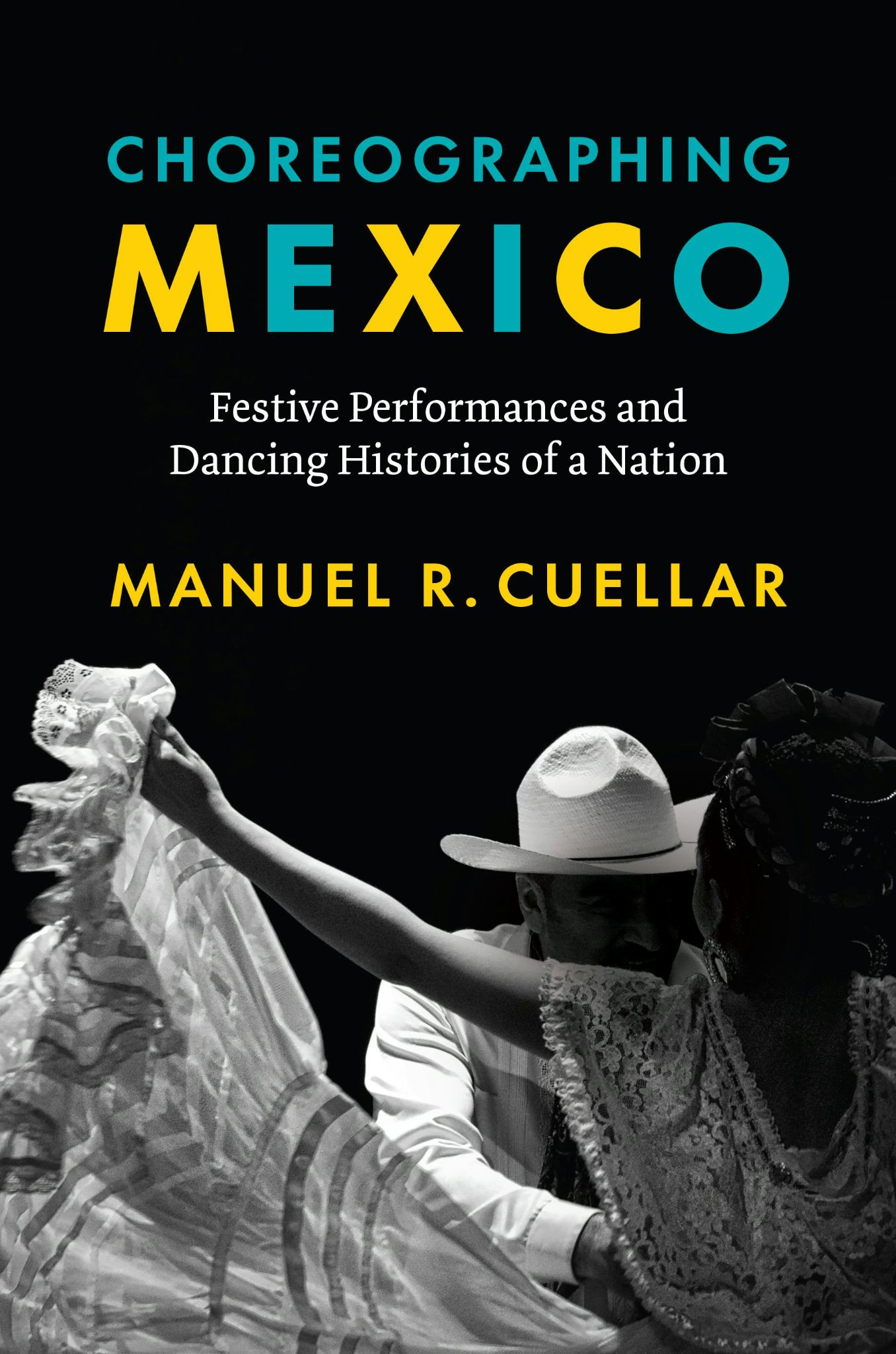
Manuel R. Cuellar
Choreographing Mexico: Festive Performances and Dancing Histories of a Nation
University of Texas Press, 2022
372 pages
$45.00
Reviewed by Jessica Peña Torres
In Choreographing Mexico: Festive Performances and Dancing Histories of a Nation, Manuel R. Cuellar examines performances of “lo mexicano” in festivals from the Porfirian regime (1876-1911) to the immediate post-revolutionary era (1910-1940). He claims that Mexican regional and traditional dance (also known as folklórico) are central to the relationship between nation and identity and that these representations reveal their inherent contradictions. A professor of Latin American and Latinx Studies and a folklórico dance practitioner, Cuellar utilizes performance as a lens and methodology to analyze four case studies. The book’s main argument is that performances of “lo mexicano” were simultaneously enforced by the state and contested by the Mexican people through social and stage embodied practices, dance, and movement. Choreographing Mexico is a groundbreaking intervention in dance studies as the first monograph in English to examine folklórico dance as fundamental to both the formation and contestation of Mexican identity ––all while centering the agency of marginalized individuals including women, queer, Indigenous and Afro-Indigenous people.
Choreographing Mexico begins with a description of Russian ballet dancer Anna Pavlova’s famous performance of the popular dance “Jarabe Tapatío” in 1919. By performing a Mexican popular dance en pointe (on her toes), claims Cuellar, Pavlova introduced Mexican regional dance into the scene of modernist concert stage, where popular dances were often “elevated.” In Chapter One, Cuellar analyzes the centennial celebrations of Mexican Independence in 1910 that took place towards the end of Porfirio Diaz’ regime. He claims that Mexico’s participation in the 1899’s World Fair in Paris served as a rehearsal for the centennial, where embodied manifestations of an exoticized Indigeneity took place. Chapter Two, focuses on La Noche Mexicana, a massive celebration at Chapultepec park that commemorated Mexico’s one-hundred years of independence. Cuellar examines the staged performances of Sonoran Yaqui dancers, jarana performers from Yucatán, and, importantly for his argument, the performance of “lo mexicano” by the people in attendance. In Chapter Three, Cuellar analyzes the massive choreographies of Nellie and Gloria Campobello in stadiums in the 1930s. While Nellie Campobello’s career, in particular, supported the construction of a hypermasculine, mestizo nation, Cuellar argues that her performances simultaneously created spaces for female and queer expressions of “lo mexicano,” complicating nationalist narratives. The last chapter meticulously examines three films of the Golden Age of cinema: Sergei Eisenstein’s ¡Que viva Mexico! (1932), Fernando de Fuentes’s Allá en el Rancho Grande (1936) and Raúl de Anda’s La reina del trópico (1946). He argues that the performance of Afro-diasporic and Afro-Indigenous dances provided contradictory renditions of a modern mestizo nation. In the epilogue, Cuellar writes from his own experience as a folklórico practitioner in California, where he urges the reader to consider embodied expressions as critical sites of knowledge.
Cuellar’s manuscript follows the scholarship of queer Latinx scholars Juana Maria Rodriguez and José Esteban Muñoz, performance studies scholar Diana Taylor, and dance studies scholar Jane C. Desmond, amongst others. Drawing from these scholars’ theories of performance, the archive, the repertoire, ephemera, and queer gestures, Cuellar provides a close reading of archival documents (historical photographs, film footage, newspapers) to explore how embodied practices, particularly folklórico dance, create layered and sometimes contradictory meanings of Mexican identity. Reading against hegemonic narratives, Cuellar draws on his dance experience to uncover alternative interpretations of performances like Nellie Campobello’s “Jarabe Tapatío.” By donning a traje de charro—traditionally worn by men—Campobello carved out possibilities for gender-subversive performances on the national stage. This is just one example of how women, Indigenous, and Afro-Indigenous individuals often resisted the nationalist project of the post-revolutionary era. “The language and images used to represent Mexico, I argue, are performatively undone by the actual embodiment of the people that they aim to represent,” says Cuellar. Utilizing a queer methodology in his examination of archival documents, he explores how race, gender, and sexuality were both performed and contested within seemingly homogeneous displays of national identity.
Cuellar’s primary intervention into the field of dance studies is how he centers folklórico dance as a fundamental tool for the rehearsal and contestation of a unified Mexican identity. In multiple instances, he engages in detailed technique-specific discussions—steps, sequences, costumes, and embodied practices—that highlight folklórico’s kinesthetic and aesthetic dimensions. For example, in Chapter Four, Cuellar analyzes the performance of “La Bamba” in La reina del trópico. He meticulously describes the fundamental steps of son jarocho, a traditional music and dance style from Veracruz, to emphasize its connections to the Mexican Caribbean and African/Black cultural traditions: “Flat right, flat left, and flat right and vice versa; shuffles changing the body weight from the right leg to the left and back to the right.” Through performance analysis, Cuellar provides kinesthetic evidence to support his argument, demonstrating how these movements function as a synecdoche for displaced Mexican Blackness. By discussing folklórico dance, he utilizes methods from both dance and performance studies to engage with the film not only culturally but also kinesthetically.
Another powerful intervention is how Cuellar focuses not only on stage but also social performances of “lo mexicano.” In various instances, he analyzes the audience’s facial expressions, body language, and social choreography to assess how they simultaneously conformed to and disrupted the nationalist project. In Chapter One, for instance, Cuellar analyzes the Desfile Histórico of 1910. He argues that in an event aimed to promote a sense of nationalism, modernity, and cosmopolitanism—which ignored the presence and contributions of Indigenous peoples—Indigenous participants enacted a collectivity that unsettled elite expectations. Comparing and contrasting newspaper accounts, archival photos, and historical footage, Cuellar argues that urban and peasant Indigenous folks moved through the public space in a way that allowed them to experience and at times enjoy the desfile as much as the middle and upper classes. “All these people witness the Desfile, occupy the same space, clap together, and share a festive experience, rehearsing a contingent embodied sociality,” writes Cuellar. Through gestures, clothing, and movement, Indigenous peoples resisted portrayals that sought to relegate them to the past.
While the state might have crafted a unified vision of the nation in a period of modernization, the people performing this vision were simultaneously conforming to and contesting these representations. Women, queer, Indigenous and Afro-Indigenous people, Cuellar argues, often upended the state’s attempt at creating a unified vision of “lo mexicano”—as that which is mestizo, macho, heteronormative. Rather than passively absorbing nationalist narratives, these groups introduced what he calls an ‘excess’ of Mexican identity—performances that exceeded and subverted official representations. Choreographing Mexico is an essential contribution to dance studies, performance studies, and Mexican cultural history. Cuellar’s work, moreover, is particularly valuable for scholars of performance and Latin American studies, as it offers a nuanced understanding of how popular dance functioned as both a tool of state formation and a site of resistance. By foregrounding folklórico as an embodied practice with deep political implications, Cuellar challenges hegemonic narratives and opens new avenues for understanding Mexican identity through performance. His book is a must-read for those interested in the intersections of dance, race, gender, and nationalism.

